5 X CONGO TETRA LIVE TROPICAL FISH AQUARIUM TANK PLANT 2-4 Cm, Vibrant Friends for Your Freshwater Tank, Easy to Care For and Perfectly Sized for Any Aquarium Community, Stunning Colors for Your Aquatic Display
£22.49 Original price was: £22.49.£18.99Current price is: £18.99.
Welcome these beautiful Congo Tetras to your aquarium! This listing includes 5 individual Congo Tetras, known for their vibrant colors and graceful movements. Perfect for beginners, they thrive in community tanks, making them ideal peaceful companions for your freshwater setup.
Species Introduction
The Congo Tetra, scientifically known as Paracheirodon innesi, is a captivating species belonging to the Characidae family. Originating from the lush freshwater rivers and streams of the Congo Basin in Africa, these beautiful fish thrive in densely vegetated areas where they find shelter and food. Their vibrant colors and graceful swimming patterns make them a popular choice among aquarists looking to create a lively community tank. With a maximum length of approximately 4 cm, the Congo Tetra is perfectly sized for a variety of aquarium setups, making them ideal companions for both novice and experienced fish keepers.
Care Requirements Dashboard
✓ Care Level: Easy
| Parameter | Ideal Range |
|---|---|
| Tank Size | Minimum 20 gallons |
| pH Level | 6.0 – 7.5 |
| Temperature | 22°C – 28°C (72°F – 82°F) |
| Hardness | 5 – 15 dGH |
Congo Tetras are known for their peaceful nature, which makes them suitable for community tanks. They thrive in well-planted aquariums with plenty of hiding spots, which mimic their natural habitat. Regular water changes and monitoring of water parameters are essential for their health and well-being.
Natural Behavior & Temperament
Congo Tetras are social fish that exhibit a lively demeanor. They are often seen swimming in schools, displaying their vibrant colors and graceful movements. This schooling behavior not only enhances their visual appeal but also contributes to their overall well-being, as they feel more secure in groups. These fish are generally peaceful and can coexist with a variety of other species, making them ideal for community tanks. However, it is crucial to monitor their interactions, as some larger or more aggressive species may pose a threat to their safety.
Tank Setup Guide
Creating an ideal environment for your Congo Tetras involves replicating their natural habitat as closely as possible. Begin with a spacious tank of at least 20 gallons, ensuring that the water is clean and well-filtered. A sandy substrate or fine gravel is recommended, as it allows for easy planting of aquatic plants. Incorporate plenty of live plants, such as Java Fern or Anubias, to provide cover and create a sense of security for your fish. Additionally, adding driftwood and rocks can enhance the aesthetic appeal of the aquarium while offering hiding spots for your aquatic companions. Ensure that the lighting is moderate, as excessive brightness can stress these fish.
Water Quality Management
✓ Good Water Quality is Essential
Maintaining optimal water quality is vital for the health of your Congo Tetras. Regular water changes of 10-15% weekly will help keep nitrate levels low and ensure a stable environment. Monitor the pH levels, aiming for a range between 6.0 and 7.5, as fluctuations can lead to stress and health issues. The temperature should be kept between 22°C and 28°C (72°F – 82°F), and the hardness should range from 5 to 15 dGH. Utilizing a reliable water testing kit will allow you to keep track of these parameters effectively.
Feeding & Nutrition
Congo Tetras are omnivorous and thrive on a varied diet. A high-quality flake food should form the basis of their diet, supplemented with frozen or live foods such as brine shrimp, daphnia, and bloodworms. This diversity ensures that they receive the necessary nutrients for optimal health and coloration. Feed your Congo Tetras small amounts 2-3 times a day, ensuring that they consume the food within a few minutes to prevent overfeeding and water quality issues. It is important to observe their eating habits and adjust the feeding schedule as needed, particularly if you notice any uneaten food.
Compatibility Guide
✓ Peaceful Community Fish
| Compatible Tank Mates | Incompatible Tank Mates |
|---|---|
| Neon Tetras | Cichlids |
| Guppies | Aggressive Barbs |
| Rasboras | Large Catfish |
| Small Gouramis | Predatory Fish |
When selecting tank mates for your Congo Tetras, it is essential to choose peaceful species that will not harass or outcompete them for food. Ideal companions include other small, non-aggressive fish such as Neon Tetras, Guppies, and Rasboras. Avoid keeping them with larger or aggressive species, such as Cichlids or predatory fish, as these can pose a threat to their well-being. Always monitor the interactions between different species to ensure a harmonious community tank.
Health & Wellness
Congo Tetras are generally flourishing fish, but they can be susceptible to common freshwater diseases such as ich, fin rot, and velvet disease. Regular monitoring of their behavior and appearance is crucial for early detection of health issues. Signs of illness may include lethargy, loss of appetite, or unusual swimming patterns. Maintaining good water quality, providing a balanced diet, and ensuring a stress-free environment are key factors in preventing health problems. In case of disease, prompt treatment with appropriate medications is essential to restore their health.
Breeding Information
Breeding Congo Tetras can be a rewarding experience for aquarists. To encourage spawning, it is recommended to set up a separate breeding tank with soft, slightly acidic water and plenty of fine-leaved plants for the eggs to adhere to. The breeding pair should be well-fed with high-quality live foods leading up to the breeding event. After spawning, the parents should be removed from the tank, as they may eat the eggs. The eggs usually hatch within 24-36 hours, and the fry can be fed infusoria or finely crushed flakes until they are large enough to accept larger foods. Careful monitoring of water quality and temperature is essential during this delicate period.
Acclimation Process
When introducing new Congo Tetras to your aquarium, it is crucial to acclimate them properly to minimize stress. Begin by floating the sealed bag containing the fish in the aquarium for about 15-20 minutes to equalize the temperature. After that, gradually introduce small amounts of aquarium water into the bag over the course of an hour. This process helps the fish adjust to the new water parameters. Once acclimated, gently release the fish into the tank using a net to avoid adding bag water, which may contain harmful substances. Monitoring their behavior closely after introduction will help ensure a smooth transition.
Long-term Care
Congo Tetras can live for several years with proper care, typically around 5-8 years in a well-maintained aquarium. Regular maintenance, including water changes and tank cleaning, is essential for their longevity. As they grow, it is important to monitor their social dynamics and adjust the tank environment as needed. Providing a varied diet and ensuring a stress-free environment will contribute to their overall health and vitality. Keeping an eye on their growth and behavior will help you identify any potential issues early on.
Natural Habitat Recreation
To recreate the natural habitat of Congo Tetras in your aquarium, focus on creating a lush, planted environment that mimics the conditions of their native waters. Utilize a combination of live plants, such as Amazon Sword and Vallisneria, to provide cover and hiding spots. Incorporate driftwood and rocks to create a more natural landscape. The water should be slightly acidic and soft, reflecting the conditions found in the Congo Basin. By replicating their natural habitat, you will not only enhance the beauty of your aquarium but also promote the health and well-being of your fish.
Seasonal Care Adjustments
As seasons change, so do the environmental conditions in your aquarium. During warmer months, it may be necessary to monitor the water temperature closely, as higher temperatures can stress your Congo Tetras. Ensure proper aeration and consider using a fan or chiller if temperatures rise significantly. In winter, maintaining a stable temperature is crucial, so avoid placing the tank near drafty windows or heating vents. Adjusting the lighting duration to mimic natural day/night cycles can also help maintain a healthy environment for your fish.
Expert Tips
For those looking to provide the best care for their Congo Tetras, consider the following expert tips: First, always quarantine new fish before introducing them to your main tank to prevent the spread of disease. Second, maintain a well-planted aquarium to reduce stress and provide hiding spots. Third, ensure that your tank is well-cycled before adding fish to create a stable environment. Lastly, engage with your fish by observing their behavior and interactions, as this can provide valuable insights into their health and happiness.
Troubleshooting
If you encounter issues with your Congo Tetras, such as unusual behavior or signs of illness, it is essential to act quickly. Common problems include stress from aggressive tank mates, poor water quality, or inadequate diet. Regularly test water parameters and make adjustments as needed. If you notice signs of disease, such as white spots or frayed fins, consult a reliable resource for treatment options. Keeping a detailed log of your tank conditions and fish behavior can help you identify patterns and troubleshoot effectively.
Scientific Background
The Congo Tetra is a member of the Characidae family, which includes many popular aquarium species. Their scientific classification is as follows: Kingdom Animalia, Phylum Chordata, Class Actinopterygii, Order Characiformes, Family Characidae, Genus Paracheirodon, Species innesi. Conservation efforts are vital for the habitats of these fish due to environmental changes and habitat destruction. Supporting sustainable practices can help ensure the survival of this beautiful species in the wild.
Advanced Care Techniques
For experienced aquarists looking to take their care of Congo Tetras to the next level, consider implementing advanced techniques such as breeding programs or biotope aquariums. Creating a biotope that closely resembles their natural habitat can enhance their colors and overall health. Additionally, experimenting with different plant species and tank layouts can lead to a more dynamic environment. Regularly participating in aquarist forums and communities can also provide valuable insights and tips from fellow enthusiasts.
Water Quality Parameters
Optimal Range
24-27°C
6.5-7.5
0 ppm
Caution Zone
22-24°C or 27-29°C
6.0-6.5 or 7.5-8.0
0.25-0.5 ppm
Danger Zone
<22°C or >29°C
<6.0 or >8.0
>0.5 ppm
Monitoring Tip: Test water parameters weekly and perform regular water changes to maintain optimal conditions for your aquatic friends!
Frequently Asked Questions
Q: What tank size is required for Congo Tetra?
Congo Tetras thrive best in a tank that is at least 60 litres (15 gallons) or larger. This size allows ample swimming space, which is essential as these fish are active swimmers. A larger tank also helps maintain stable water parameters, reducing stress and enhancing their vibrant colours. When setting up the aquarium, consider providing plenty of hiding spots and swimming areas, as this will mimic their natural habitat and promote a healthy environment for your aquatic companions.
✓ Expert Tip
Aim for a larger group of at least six Congo Tetras to promote social behaviour and reduce stress.
Q: What water parameters do Congo Tetra require?
Congo Tetras prefer slightly acidic to neutral water, with a pH range of 6.0 to 7.5. The ideal temperature for these fish is between 24°C and 28°C (75°F to 82°F). Regular water changes of about 25% weekly will help maintain optimal water quality by removing toxins and replenishing essential minerals. Additionally, ensure that water hardness is kept between 2-15 dGH. Monitoring these parameters will not only enhance the health of your fish friends but also bring out their vibrant colours.
✓ Expert Tip
Using a quality water conditioner can help neutralise harmful chemicals in tap water.
Q: How often should I feed Congo Tetra?
Congo Tetras should be fed 2-3 times a day, offering only as much food as they can consume within a few minutes. A varied diet consisting of high-quality flake food, micro-pellets, and occasional live or frozen foods such as brine shrimp or daphnia will ensure they receive essential nutrients. Overfeeding can lead to poor water quality, so always monitor their intake and remove any uneaten food promptly.
✓ Expert Tip
Incorporate a range of foods to enhance their colour and overall health.
Q: What are the best tank mates for Congo Tetra?
Congo Tetras are peaceful and social fish, making them ideal companions for other non-aggressive species. Suitable tank mates include other Tetra species, Guppies, Corydoras, and peaceful Cichlids. Avoid keeping them with overly aggressive fish that may stress them. It’s always wise to introduce new tank mates gradually and monitor their interactions to ensure a harmonious community.
✓ Expert Tip
Create a diverse community tank with plenty of hiding spots to reduce stress.
Q: How do I properly acclimatise Congo Tetra to my aquarium?
Acclimatisation is crucial for reducing stress during the transition to a new environment. Begin by floating the sealed bag containing the Congo Tetras in your aquarium for about 15-20 minutes, allowing the temperature to equalise. After that, gradually introduce small amounts of aquarium water into the bag every 5 minutes for around 30 minutes. Finally, gently place the fish into the tank using a net to avoid adding bag water, which may contain harmful substances.
✓ Expert Tip
Always use a quarantine tank for new arrivals to prevent disease spread.
Q: What are the signs of healthy Congo Tetra?
Healthy Congo Tetras display vibrant colours, swim actively, and exhibit social behaviour with tank mates. Their fins should be fully extended, and they should not show signs of lethargy or hiding excessively. Additionally, check for clear eyes, smooth scales, and a healthy appetite. Any drastic changes in behaviour or appearance may indicate stress or illness, warranting immediate attention.
✓ Expert Tip
Regular observation helps in early detection of health issues.
Q: How do I successfully breed Congo Tetra?
Breeding Congo Tetras requires a separate breeding tank with soft, slightly acidic water and plenty of fine-leaved plants for the eggs to adhere to. Condition the breeding pair with high-quality foods to stimulate spawning. Once ready, the female will scatter eggs amongst the plants. After spawning, remove the parents to prevent them from eating the eggs. The eggs will hatch in approximately 24-36 hours, and the fry can be fed infusoria or liquid fry food until they are large enough for powdered foods.
✓ Expert Tip
Maintain stable water conditions to ensure successful breeding.
Q: What temperature should I maintain for Congo Tetra?
Congo Tetras thrive within a temperature range of 24°C to 28°C (75°F to 82°F). Maintaining this temperature range is crucial as it influences their metabolism, behaviour, and overall health. Sudden fluctuations can lead to stress and health issues. A reliable aquarium heater coupled with a thermometer will help ensure the temperature remains stable. Regular monitoring is essential to provide the best living conditions for your aquatic companions.
✓ Expert Tip
Consider using a heater with a thermostat for greater temperature accuracy.
Q: How long do Congo Tetra typically live in captivity?
Congo Tetras can live for approximately 5 to 8 years in a well-maintained aquarium. Their lifespan is influenced by water quality, diet, and overall care. Providing a stable environment and proper nutrition will significantly contribute to their longevity. Regular tank maintenance and health monitoring can help prevent diseases that may shorten their lifespan.
✓ Expert Tip
Keep a consistent care routine to promote a longer, healthier life.
Q: What type of substrate is most suitable for Congo Tetra?
Congo Tetras do not have specific substrate preferences; however, a soft, dark substrate is often recommended as it enhances their colours and mimics their natural habitat. Sand or fine gravel is ideal as it is gentle on their delicate fins. Additionally, a darker substrate can encourage the Tetras to display their vibrant colours more prominently, creating a stunning visual effect in your aquarium.
✓ Expert Tip
Consider adding plants and decorations to provide additional cover and stimulate natural behaviours.
Q: What behavioural patterns should I expect from Congo Tetra?
Congo Tetras are known for their active and social behaviour. They are schooling fish, so they prefer to be in groups of six or more, which helps reduce stress and encourages natural behaviours. You will often observe them swimming in the middle to upper areas of the tank, displaying playful interactions with their companions. Their curious nature means they will explore their environment frequently, and they may exhibit more vibrant colours when they feel secure and comfortable.
✓ Expert Tip
Providing plenty of swimming space and hiding spots will keep them happy and healthy.
Q: How can I prevent common diseases in Congo Tetra?
Preventing disease in Congo Tetras starts with maintaining excellent water quality through regular water changes and proper filtration. Quarantining new arrivals before introducing them to your main tank is essential to avoid disease transmission. Additionally, providing a balanced diet and ensuring the tank is not overcrowded will help keep stress levels low, reducing the risk of illness. Regular observation for any signs of illness, such as unusual swimming patterns or changes in appetite, is crucial for early detection and treatment.
✓ Expert Tip
Invest in a quality water test kit to monitor water parameters effectively.
Q: What lighting conditions do Congo Tetra prefer?
Congo Tetras thrive under moderate lighting conditions. Bright, direct light may cause stress, so it is advisable to use a light that mimics their natural habitat, which often includes shaded areas. Using a combination of floating plants and tall aquatic plants can help diffuse the light and create a more natural environment. A light cycle of about 10-12 hours a day is typically sufficient to promote healthy growth of both plants and fish.
✓ Expert Tip
Consider using a timer to maintain a consistent light cycle.
Q: How do I recognise stress in Congo Tetra?
Recognising stress in Congo Tetras is crucial for their health. Signs of stress may include excessive hiding, erratic swimming patterns, and loss of colour vibrancy. If they are constantly at the bottom of the tank or displaying a lack of appetite, it may indicate stress related to water quality, tank mates, or other environmental factors. Ensuring a stable environment with appropriate water parameters and providing plenty of hiding spots can help alleviate stress.
✓ Expert Tip
Regularly check water quality and tank conditions to prevent stress.
Q: What natural habitat conditions should I replicate for Congo Tetra?
Congo Tetras originate from the slow-moving rivers and streams of the Congo Basin, where they inhabit areas with dense vegetation. To replicate their natural habitat, incorporate plenty of plants, driftwood, and rocks into your aquarium. Using a dark substrate and maintaining slightly acidic, soft water will also help create a more suitable environment. Providing hiding spots and open swimming areas will encourage natural behaviours and promote overall well-being.
✓ Expert Tip
Regularly trim and maintain plants to prevent overcrowding in the tank.

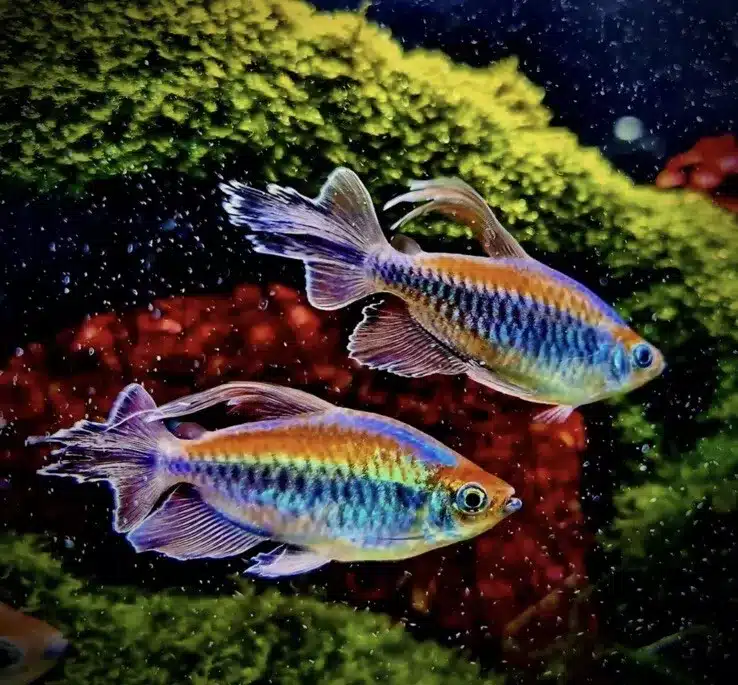
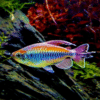




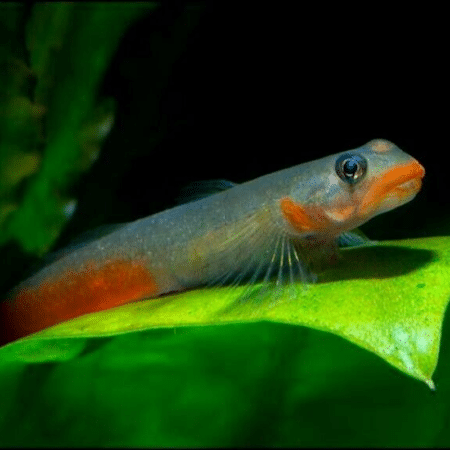



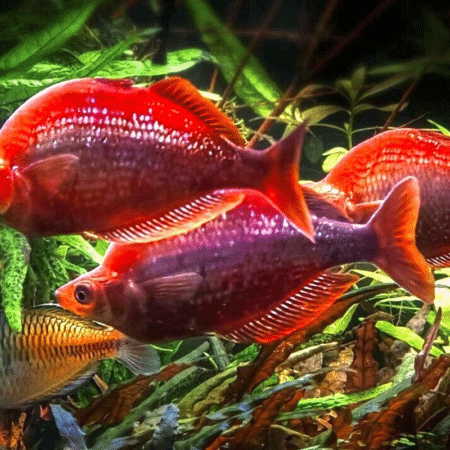


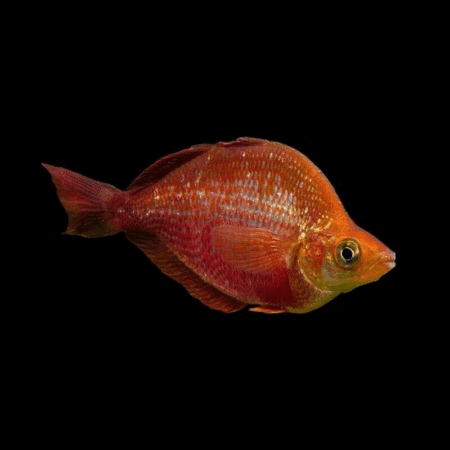
Lisa Green (verified owner) –
I recently purchased the 5 Congo Tetras for my 55-gallon community tank, and I couldn’t be happier! After just two weeks, these little beauties have added a burst of color and energy to my aquarium. They swim gracefully in schools, displaying their vibrant colors beautifully, especially against the lush plants I have. Compared to other freshwater fish I’ve kept, like neon tetras, these Congo tetras are far more active and social, making my tank more lively.
I appreciate how healthy they arrived—each fish was vibrant and active, clearly well-cared for before shipping. It’s evident that they thrive in groups, which has made my tank more dynamic. The only minor concern I had was that they are a bit skittish at first, but they quickly adjusted and now feel right at home. I highly recommend these fish for anyone looking to add some colorful character to their setup. They are perfect for both beginner and experienced aquarists, especially if you have a planted aquarium like mine. Overall, a fantastic purchase that I would absolutely make again!
Emily Carter (verified owner) –
I recently added 5 Congo Tetras to my freshwater tank, and I couldn’t be happier! These vibrant fish are not only beautiful with their shimmering scales and playful personalities, but they are also easy to care for, making them perfect for my community tank. After just two weeks, I’ve noticed how they have settled in and are swimming gracefully with my other tropical fish. The 2-4 cm size was ideal for my setup, and they’ve quickly become the highlight of my aquarium.
Compared to other tetras I’ve kept, Congo Tetras are much more active and social, often schooling together, which is a joy to watch. I did have a minor concern regarding their dietary needs, as they do appreciate a varied diet, but it’s not too demanding. I recommend providing them with high-quality flakes and frozen foods to keep them happy and healthy.
If you’re looking to add a splash of color and liveliness to your tank, I wholeheartedly recommend these Congo Tetras. They’ve truly brought my aquarium to life, and their well-being is a priority for me as a caring fish parent. Shipping was prompt, and they arrived in fantastic condition. Would definitely buy these again!